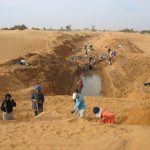In my experience, when it comes to raising funds to support social projects in Africa, I have found myself more than once having to make difficult choices. The most immediate option seems to be to invest in essential facilities such as schools, dispensaries, orphanages, etc., at “low cost”, to ensure a rapid and effective impact on communities in need. This approach is particularly crucial in regions like the Sahel, where extreme environmental conditions require rapid solutions, and the “low cost” can speed up fundraising. However, I believe there could be another perspective that could revolutionize philanthropy in Africa: the importance of investing in beauty. This concept takes on an important role in regions of West Africa, where multiple challenges require not only the creation of resistant and functional structures, but also of great architectural impact, for reasons that go well beyond the aesthetic aspect. It is undeniable that “beautiful” projects cost more than essential and functional ones. Beauty, however, goes far beyond the visual; it also involves the emotional and psychological aspect of people. Investing in beauty is not just an aesthetic luxury, but can have a lasting impact on communities and their resilience.
One of the main challenges of many development projects in Africa is sustainability. Too often, we see essential facilities built sloppily, without a long-term vision, due to budget restrictions. Schools become dilapidated, tin roofs fly off at the first storm and tiles fall from the walls of clinics to the ground, putting people’s health at risk. And while that’s not the case everywhere, I’ve seen more structures in poor condition than well-maintained ones in my travels. In this context, beauty can play a key role in building durable infrastructure, especially in the Sahel and Sahara regions, where extreme climate conditions require robust construction solutions. Investing in beautiful projects means involving local communities in their implementation. For example, when building a school with an attractive design, you can involve local craftsmen in the construction and decoration of the buildings, allowing them to apply their traditional skills in new contexts. Furthermore, the use of high quality materials, preferably local, and excellent finishes improves not only the aesthetic appearance of the structures, but also their durability and ease of maintenance. A well-designed building built with quality materials will require less maintenance over time, and this can be managed by the local workforce that contributed to its creation. High-quality building design that combines functionality and aesthetics is critical to achieving excellent results. To do this, it is essential to promote a constant exchange of information between local designers and architects. This interaction, which starts from the materials used up to the plant choices, ensures effective integration of local needs and resources in the projects, maximizing efficiency and sustainability. Supporting a project in which particular attention is paid to the entire chain, from design to implementation, in order to create a structure of social relevance, takes on significant value as a Corporate Social Responsibility initiative, an approach increasingly welcomed in the world of profit. A building structure of recognized beauty reflects positively on those who financially supported the project. Beauty also has the power to inspire and motivate people. When communities see beautiful, functional projects come to life, they are more inclined to care about them and develop a sense of pride in what they have created together. This can lead to greater participation and maintenance of structures over time. However, the idea of investing in beauty in Africa does not mean neglecting essential needs. It is important to find a balance between functionality and aesthetics, looking for solutions that can satisfy both needs. Beauty should not be a luxury, but an integral element of the development process, which takes into account the different geographical and anthropological realities present in Africa. In the Sahel, for example, where nomadic populations are closely linked to the land and the cycle of the seasons, projects that integrate beauty and functionality can foster greater stability and resilience. Spaces built with attention to design can become centers of aggregation and learning, providing support to both settled and nomadic communities in transit. In the vast African landscapes and on the outskirts of cities, architecture that reflects the beauty of the land can create a sense of belonging and cultural identity. This can lead to the preservation of local traditions and the valorization of natural resources, while promoting environmental sustainability and projecting the community towards the future. In conclusion, beauty can actually contribute to saving Africa, but only if considered as an integral part of development projects. Investing in beautiful projects not only improves the visual appearance of structures, but also helps create stronger, more resilient communities. The balance between functionality, sustainability and beauty is fundamental to ensuring a prosperous and sustainable future for Africa, taking into account its diverse geographical and anthropological realities. Beauty can be a beacon of hope in an ever-changing continent.


